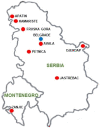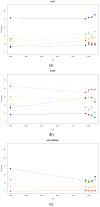The Adaptive Value of Chromosomal Inversions and Climatic Change-Studies on the Natural Populations of Drosophila subobscura from the Balkans
- PMID: 37504602
- PMCID: PMC10380441
- DOI: 10.3390/insects14070596
The Adaptive Value of Chromosomal Inversions and Climatic Change-Studies on the Natural Populations of Drosophila subobscura from the Balkans
Abstract
The adaptive value of the Drosophila subobscura chromosomal inversion polymorphism with regard to environmental effects is well-known. However, the specific details of the inversion adaptations to the global warming scenario deserve to be analyzed. Toward this aim, polymorphism and karyotypes were studied in 574 individuals from Petnica (Serbia) in annual samples taken in June for the period 2019-2022. Comparing the results of Petnica (Cfa: humid subtropical climate) with those from Avala (Serbia: Cfb, temperate oceanic climate) and Font Groga (Barcelona, Spain; Csa: hot-summer Mediterranean climate), significant differences were observed for their chromosomal polymorphism. In Petnica, inversions from U and E chromosomes mainly reacted significantly with regard to temperature, humidity, and rainfall. Moreover, the inversion polymorphism from Petnica (2019-2022) was compared with that from 1995. In this period, a significant increase in mean and maximum temperature was observed. However, to properly explain the observed variations of inversions over time, it was necessary to carefully analyze annual seasonal changes and particular heat wave episodes. Interestingly, yearly fluctuations of U chromosome 'warm'-adapted inversions corresponded with opposite changes in 'non-thermal' inversions. Perhaps these types of inversions were not correctly defined with regard to thermal adaptation, or these fluctuations were also due to adaptations to other physical and/or biological variables. Finally, a joint study of chromosomal inversion polymorphism from many Balkan populations of D. subobscura indicated that different climatic regions presented distinct composition, including thermal-adapted inversions.
Keywords: adaptation; chromosomal thermal index; global warming; natural selection; temperature.
Conflict of interest statement
The authors declare no conflict of interest.
Figures





References
-
- IPCC . Climate Change 2021: The Physical Science Basis. In: Masson-Delmotte V., Zhai P., Pirani A., Connors S.L., Péan C., Berger S., Caud N., Chen Y., Goldfarb L., Gomis M.I., et al., editors. Contribution of Working Group I to the Sixth Assessment Report of the Intergovernmental Panel on Climate Change. Volume 3. Cambridge University Press; Cambridge, UK: New York, NY, USA: 2021. pp. 154–196. - DOI
-
- IPCC . Summary for Policymakers. In: Shukla P.R., Skea J., Slade R., Al Khourdajie A., van Diemen R., McCollum D., Pathak M., Some S., Vyas P., Fradera R., et al., editors. Climate Change 2022: Mitigation of Climate Change. Contribution of Working Group III to the Sixth Assessment Report of the Intergovernmental Panel on Climate Change. Cambridge University Press; Cambridge, UK: New York, NY, USA: 2022. - DOI
-
- Ripple W.J., Wolf C., Newsome T.M., Galetti M., Alamgir M., Crist E., Mahmoud M.I., Laurance W.F. World scientists’ warning to humanity: A second notice. BioScience. 2017;67:1026–1028. doi: 10.1093/biosci/bix125. - DOI
-
- Ripple W.I., Wolf C., Newsome T.M., Barnard P., Moomaw W.R., Grandcolas P. World scientists’ warning of a climate emergency. BioScience. 2020;70:8–12. doi: 10.1093/biosci/biz152. - DOI
-
- Ripple W.J., Wolf C., Gregg J.W., Levin K., Rockström J., Newsome T.M., Betts M.G., Huq S., Law B.E., Kemp L., et al. World scientists’ warning of a climate emergency 2022. BioScience. 2022;72:1149–1155. doi: 10.1093/biosci/biac083. - DOI
Grants and funding
- CTM2015-66-400-C3-3-R/Ministry of Economy, Industry and Competitiveness
- PID2020-118550RB-C22/Ministry of Economy, Industry and Competitiveness
- 2021SGR01271/Government of Catalonia
- 2021SGR1421/Government of Catalonia
- 451-03-47/2023-01/200007/Ministry of Science, Technological Development and Innovation. Rep. SERBIA
LinkOut - more resources
Full Text Sources
Molecular Biology Databases
Miscellaneous

